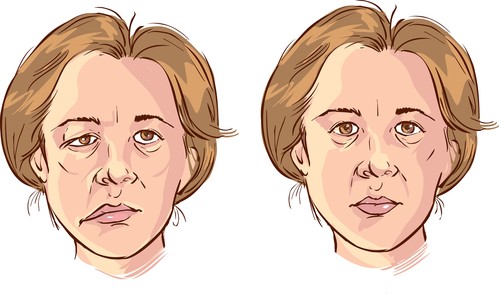
Contents
In this article, we will take a look at:
- What is Bell’s palsy?
- How does Bell’s palsy occur?
- Who is prone to Bell’s palsy?
- Symptoms of Bell’s palsy
- Diagnosis of Bell’s palsy
- Complications of Bell’s palsy
- Treatment for Bell’s palsy
You can click on any of the links above to navigate to the section of your interest.
What is Bell’s palsy?
This condition is named after the famous anatomist Charles Bell who was the first to connect these symptoms to facial nerve involvement. Bell’s palsy is a neurological disease that affects the nerves controlling the facial muscles. The facial muscles are responsible for your expressions. Those affected by this condition, experience temporary paralysis of the face muscles. One side of the face appears to be drooping or appears to be stiff.
This condition is almost always temporary in nature and should get resolved within a few weeks. In Bell’s palsy, the seventh cranial nerve, called the facial nerve is affected. There are many conditions that cause temporary damage to the facial nerve, leaving it either swollen or compressed.
How does Bell’s palsy occur?
Bell’s palsy occurs as a result of conditions that lead to facial nerve compression or swelling. While the exact cause for Bell’s palsy is unknown, it has been observed in patients who have a recent history of viral infections.
The following viral conditions are known to affect the facial nerve:
- Herpes Simplex Virus
- HIV Virus
- Herpes Zoster Virus
- Espstein Barr Virus
Other conditions that lead to facial nerve palsy are:
- Sarcoidosis
- Lyme Disease
- Tumours compressing the nerve
Who is Prone to Bell’s palsy?
Bell’s palsy does not usually have a target group. The people who are generally more prone to this condition are those aged between 16 and 60 years of age.
The chances of you getting Bell’s palsy are generally higher if you have any of the following risk factors:
Pregnancy is a trigger for Bell’s palsy. This is because the body is in an immunocompromised state and thereby is more prone to viral infections. This is more applicable to those who suffer from gestational diabetes.
Diabetes is an endocrinological condition that suppresses the immune system, thereby leaving the patient susceptible to all kinds of infections.
Those who have a recent history of or ongoing condition of lung disease are prone to Bell’s palsy.
Studies have shown that there is a familial factor involved in the transmission of Bell’s palsy.
What are the symptoms of Bell’s palsy? How is Bell’s palsy diagnosed?
Preceding the onset of the condition, the patient observes symptoms related to viral infections such as cold symptoms, ear infection symptoms, among others.
The specific symptoms of Bell’s palsy are:
- Uncontrolled drooling
- Facial expressions are improper
- Crooked, one-sided smile.
- Facial weakness
- Difficulty in eating food and drinking fluids.
- The eye on the affected side maybe irritable
- Twitching in the muscles of the face
- Dryness in the mouth
- Dryness in the eyes
- Complaints of headaches
Diagnosis
Bell’s palsy is diagnosed by following general examination and specific neurological examination.
General examination includes looking for any external signs of infection, rashes, etc.
Neurological examination includes testing the patients’ higher mental functions, memory, etc. before testing the facial muscles to assess the exact amount of their involvement. The facial muscles are tested for their strength, elasticity and tautness.
Blood tests are done to look for infections and tumours. Serologists take about a week to confirm the presence of viral infections.
Imaging: CT scans and MRIs are done to get a look at the affected nerve and identify the presence of any masses as well as the extent up to which the nerve has been affected.
Complications of Bell’s palsy
Majority of the cases of Bell’s palsy often undergo complete remission and the patients have absolutely no complications whatsoever. In rare cases, however, the following complications can be expected:
Permanent damage to the seventh nerve also known as the facial nerve. This is a cranial nerve that controls the actions of facial muscles. The dryness in the eyes of the patients must be rectified soon before it leads to complications such as infections or ulcers that may cause the patient to end up losing their eyes.
A condition known as synkinesis may develop. This is a condition where when a particular group of muscles voluntarily move, another group moves along involuntarily.
Treatment for Bell’s palsy
Most patients undergo spontaneous remission and might not require treatment at all. But if the palsy doesn’t rectify itself, here’s what your doctors can do.
Treatment is often done using corticosteroids to bring down the swelling present in the nerves. Antibiotics are used to treat the underlying viral infections. Pain relief medications like regular acetaminophen tablets are administered. Hydrating eye drops may be used too.
Questions answered by trusted doctors



Remedies
Cover the dry eye using an eye patch
Cover the dry eye using an eye patch, so that the dryness doesn’t get aggravated or damage your eyes further.
Did you know?
Spontaneous remission in Bell's Palsy
Most patients undergo spontaneous remission and might not require treatment at all. But if the palsy doesn’t rectify itself, here’s what your doctors can do.
Related videos
Related articles
Brain Cancer refers to the presence of such abnormal cells in a person’s brain.
Cholelithiasis is a medical condition where hard, pebble-like deposits develop within the gallbladder of an individual. They are also known as gallstones. These stones can be as small as a grain of sand or as large as a golf ball.
Infertility refers to a woman’s inability to conceive despite having unprotected, well-timed sexual intercourse for over a year. Infertility can be caused by many factors.

